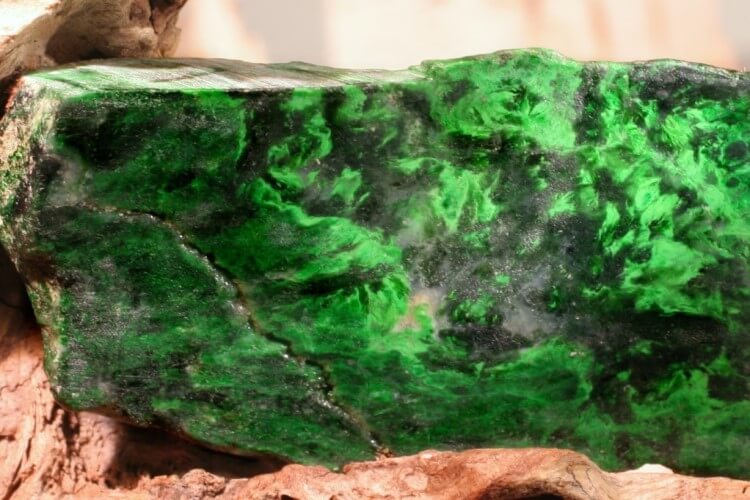
This rock would formerly have been called "chloromelanite". Nowadays this name is obsolete..
Foto: K. Sieber, www.makrogalerie.de
The name "chloromelanite" dates back to the Greek "chloros" (green) and "melas" (black) and describes the appearance of a rock consisting of a green ground mass with black spots. The usage of this name has always been handled inconsistently in mineralogy and gemmology. As a result, very different rocks have been referred to in literature as chloromelanite, e.g. eclogite or omphacite [Essene & Fyfe, 1967] or a rock containing jadeite from Burma, which nowadays is called Maw-sit-sit Jade [Gübelin, E., 1964].
On many websides chloromelanite is defined simply as a "variety of jadeite". Slightly more precise is Wikipedia, where chloromelanite is described as "a mixed crystal consisting of aegirine, diopside and jadeite with a mixing ratio of about 1:1:1". This coincides to the definition of the German Gemmological Association [Henn, 2008]. However, mixed crystals with the mixing ratio stated above bear the mineral name "Omphacite" nowadays. Omphacite is accepted as a mineral in its own right by the CNMNC (Commission on New Minerals, Nomenclature and Classification) responsible for the naming of minerals. Chloromelanite on the other hand, is not recognized as a mineral name.
Therefore, it is not surprising that some authors define chloromelanite as an "outdated name for omphacite or aegirin-augite" [Börner, Hill, 2012].
But what is correct now? Is chloromelanite aegirin-augite or omphacite or even jadeite?
The renowned mineralogist W. E. Tröger sheds light on the subject in his paper "Zur Systematik und Optik der Chloromelanit-Reihe" ("On the Classification and Visual Appearance of the Chloromelanite Groupe") which gives an profound overview of the term chloromelanite. According to him, the term was not coined by a geoscientist, but by the archaeologist A. Dumour, who was engaged in the analysis and survey of stone-age tools. Dumour used this name to describe all green-black patterned rocks of high density that seemed to consist of iron-rich jadeite. In accordance with the behavior of his time (1865), the new name identified both the mineral and the corresponding rock.
However, among the prehistoric stone axes of dark green color and high density there are also some objects that consist, for example, of a mixture of jadeite with hornblende or of omphacite with glaucophane or similar rock compositions. They were also called "chloromelanite" by different authors in the aftermath. As a result, this term had no informative value any more. [Tröger, 1962]. Since then it has been considered outdated because it was far too unspecific for a scientifically correct nomenclature. In the following period, the various rocks previously referred to as chloromelanite were given new names and were addressed with their mineralogically correct names.
In gemmological literature, however, the term continued to be used until the end of the 20th century [Schumann, 1997; Webster, 2000] and served as an outdated synonym for a rock that is now known worldwide as Maw-sit-sit Jade.
Chloromelanite is a nice example to show how a rock name, which was created in the 19th century, had to be re-named or defined more precisely in the 20th century due to the rapidly developing analytical skills and the resulting explosion in knowledge.
References:
Börner, K. & Hill, D. (2012): Große Enzyklopädie der Steine; 15. Aufl.; Abraxas Verlag; Hasede, ISBN 978-3-934219-17-5.
Essene, E.J. & W.S. Fyfe (1967): Omphacite in California metamorphic rocks. Contributions to Mineralogy and Petrology: 15, 23 pp
Henn, U. (2008): Bestimmungstabellen.- Deutsche Gemmologische Gesellschaft (DGemG); Eigenverlag
Schumann, W. (1997): Der neue BLV Steine- und Mineralienführer.- Blv Buchverlag; ISBN-10: 3405153026
Tröger. W. E. (1962): Zur Systematik und Optik der Chloromelanit-Reihe.- Mineralogy and petrology, Vol. 8, 24-35, ISSN 1438-1168
Webster, R. & Read, P.G. (2000): Gems, Their Sources, Descriptions and Identification.- Butterworth-Heinemann; 273-274; ISBN-10: 0750616741



